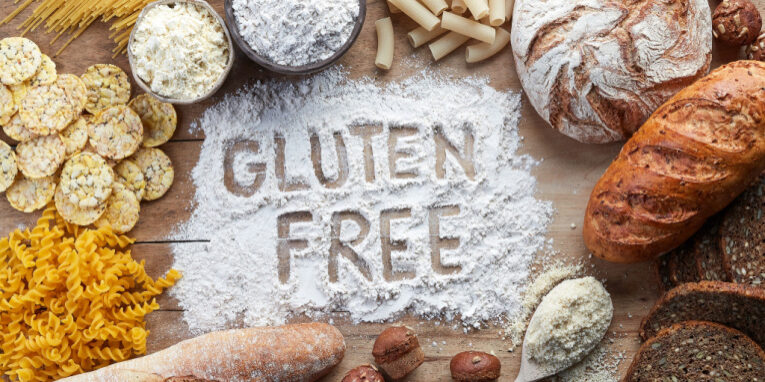Gluten-Free Diet (Celiac)

Gluten-free diet: What’s allowed, what’s not
A gluten-free diet is a diet that excludes the protein gluten. Gluten is found in grains such as wheat, barley, rye and triticale (a cross between wheat and rye).
A gluten-free diet is used to treat celiac disease. Gluten causes inflammation in the small intestines of people with celiac disease. Eating a gluten-free diet helps people with celiac disease control their signs and symptoms and prevent complications.
Initially, following a gluten-free diet may be frustrating. But with time, patience and creativity, you’ll find there are many foods that you already eat that are gluten-free and you will find substitutes for gluten-containing foods that you can enjoy.
Purpose
The gluten-free diet is a treatment for celiac disease.
Diet details
Switching to a gluten-free diet is a big change and, like anything new, it takes some getting used to. You may initially feel deprived by the diet’s restrictions. However, try to stay positive and focus on all the foods you can eat. You may also be pleasantly surprised to realize how many gluten-free products, such as bread and pasta, are now available. Many specialty grocery stores sell gluten-free foods. If you can’t find them in your area, check with a celiac support group or go online.
If you’re just starting with a gluten-free diet, it’s a good idea to consult a dietitian who can answer your questions and offer advice about how to avoid gluten while still eating a healthy, balanced diet.
Allowed foods
Many healthy and delicious foods are naturally gluten-free:
- Beans, seeds, nuts in their natural, unprocessed form
- Fresh eggs
- Fresh meats, fish and poultry (not breaded, batter-coated or marinated)
- Fruits and vegetables
- Most dairy products
It’s important to make sure that they are not processed or mixed with gluten-containing grains, additives or preservatives. Many grains and starches can be part of a gluten-free diet:
- Amaranth
- Arrowroot
- Buckwheat
- Com and cornmeal
- Flax
- Gluten-free flours (rice, soy, com, potato, bean)
- Hominy (corn)
- Millet
- Quinoa
- Rice
- Sorghum
- Soy
- Tapioca
- Teff
Always avoid
Avoid all food and drinks containing:
- Barley (malt, malt flavoring and malt vinegar are usually made from barley)
- Rye
- Triticale (a cross between wheat and rye)
- Wheat
Avoiding wheat can be challenging because wheat products go by numerous names. Consider the many types of wheat flour on supermarket shelves – bromated, enriched, phosphated, plain and self-rising. Here are other wheat products to avoid:
- Bulgur
- Durum flour
- Farina
- Graham flour
- Kamut
- Semolina
- Spelt
Avoid unless labeled ‘gluten-free’
In general, avoid the following foods unless they’re labeled as gluten-free or made with com, rice, soy or other gluten-free grain:
- Beer
- Breads
- Cakes and pies
- Candies
- Cereals
- Cookies and crackers
- Croutons
- French fries
- Gravies
- Imitation meat or seafood
- Matzo
- Pastas
- Processed luncheon meats
- Salad dressings
- Sauces, including soy sauce
- Seasoned rice mixes
- Seasoned snack foods, such as potato and tortilla chips
- Self-basting poultry
- Soups and soup bases
- Vegetables in sauce
Certain grains, such as oats, can be contaminated with wheat during growing and processing stages of production. For this reason, doctors and dietitians generally recommend avoiding oats unless they are specifically labeled gluten-free.
You should also be alert for other products that you eat or that could come in contact with your mouth that may contain gluten. These include:
- Food additives, such as malt flavoring, modified food starch and others
- Medications and vitamins that use gluten as a binding agent
- Play dough
Watch for cross-contamination
Cross-contamination occurs when gluten-free foods come into contact with foods that contain gluten. It can happen during the manufacturing process, for example, if the same equipment is used to make a variety of products. Some food labels include a “may contain” statement if this is the case. But be aware that this type of statement is voluntary. You still need to check the actual ingredient list. If you’re not sure whether a food contains gluten, don’t buy it or check with the manufacturer first to ask what it contains.
Cross-contamination can also occur at home if foods are prepared on common surfaces or with utensils that weren’t thoroughly cleaned after being used to prepare gluten-containing foods.
Using a common toaster for gluten-free bread and regular bread is a major source of contamination, for example. Consider what steps you need to take to prevent cross contamination at home, school or work.
